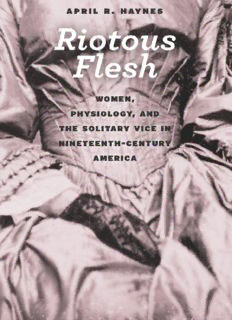
Riotous Flesh: Women, Physiology, and the Solitary Vice in Nineteenth-Century America PDF
Preview Riotous Flesh: Women, Physiology, and the Solitary Vice in Nineteenth-Century America
riotous flesh american beginnings, 1500– 1 900 A Series Edited by Edward Gray, Stephen Mihm, and Mark Peterson also in the series Holy Nation: The Transatlantic Quaker Ministry in an Age of Revolution by Sarah Crabtree A Hercules in the Cradle: War, Money, and the American State, 1783– 1867 by Max M. Edling Frontier Seaport: Detroit’s Transformation into an Atlantic Entrepôt by Catherine Cangany Beyond Redemption: Race, Violence, and the American South after the Civil War by Carole Emberton The Republic Afloat: Law, Honor, and Citizenship in Maritime America by Matthew Taylor Raffety Conceived in Doubt: Religion and Politics in the New American Nation by Amanda Porterfield riotous flesh Women, Physiology, and the Solitary Vice in Nineteenth- Century America april r. haynes the university of chicago press chicago and london april r. haynes is assistant professor of history at the University of Oregon. The University of Chicago Press, Chicago 60637 The University of Chicago Press, Ltd., London © 2015 by The University of Chicago All rights reserved. Published 2015. Printed in the United States of America 24 23 22 21 20 19 18 17 16 15 1 2 3 4 5 isbn- 13: 978- 0- 226- 28459-0 (cloth) isbn- 13: 978- 0- 226- 28462-0 (paper) isbn- 13: 978- 0- 226- 28476-7 (e- book) doi: 10.7208/chicago/9780226284767.001.0001 Library of Congress Cataloging-in-Publication Data Haynes, April R., author. Riotous flesh : women, physiology, and the solitary vice in nineteenth-century America / April R. Haynes. pages cm Includes bibliographical references and index. isbn 978-0-226-28459-0 (cloth : alkaline paper) — isbn 978-0-226-28462-0 (paperback : alkaline paper)—isbn 978-0-226-28476-7 (ebook) 1. Women— Sexual behavior—Social aspects—United States—History—19th century. 2. Female masturbation—Social aspects—United States—History—19th century. 3. Women—United States—Attitudes—History—19th century. 4. Feminism— United States—History—19th century. I. Title. hq29.h39 2015 305.42097309'034—dc23 2015003802 ♾ This paper meets the requirements of ansi/niso z39.48- 1992 (Permanence of Paper). for hex contents Introduction 1 1. The Gender of Solitary Vice 26 2. Licentiousness in All Its Forms 56 3. Making the Conversation General 81 4. A Philosophy of Amative Indulgence 107 5. Flesh and Bones 132 Epilogue 163 Acknowledgments 179 Notes 183 Index 231 vii Introduction “ They used to say that masturbation would make you crazy— but I’d go crazy without it.” In responding to Shere Hite’s 1972 questionnaire on women’s sexual practices, an anonymous member of the National Organi- zation for Women acknowledged a profound historical change. The same behavior once deemed a perversion that caused insanity had come by the 1970s to represent, for many feminists, the healthiest of all sexual expres- sions. While Hite’s respondent charted a clear reversal in attitudes about masturbation, she could not account for why so many Americans had ever believed that it “would make you crazy.”1 What did seem clear to many feminists was that patriarchal definitions of female sexuality, not masturbation, had made women mad. Dell Wil- liams, founder of the feminist bookstore Eve’s Garden, announced that women who purchased vibrators liberated themselves from “the shame and guilt of centuries of oppression.” The writer and activist Anne Koedt was more specific. Sigmund Freud and his popularizers, who had domi- nated American sexual thought since the 1920s, had pathologized women’s natural sexual functioning in order to maintain male dominance. Freud- ians held that “vaginal orgasm,” achieved exclusively through heterosexual intercourse, signified a woman’s maturity. Women who “fixated” on the clitoris instead, particularly those who masturbated beyond the years of puberty, were described as infantile, neurotic, maladjusted, frigid, and man- nish. Koedt denounced the vaginal orgasm as a “myth” that kept women fearful and sexually dependent upon men. Women’s liberationists thus set out to demystify their bodies, to speak the “truth” about healthy female sexuality.2 To this end, feminists began to distribute two kinds of information: first, physiological studies, such as those conducted by William Masters and 1
Description: